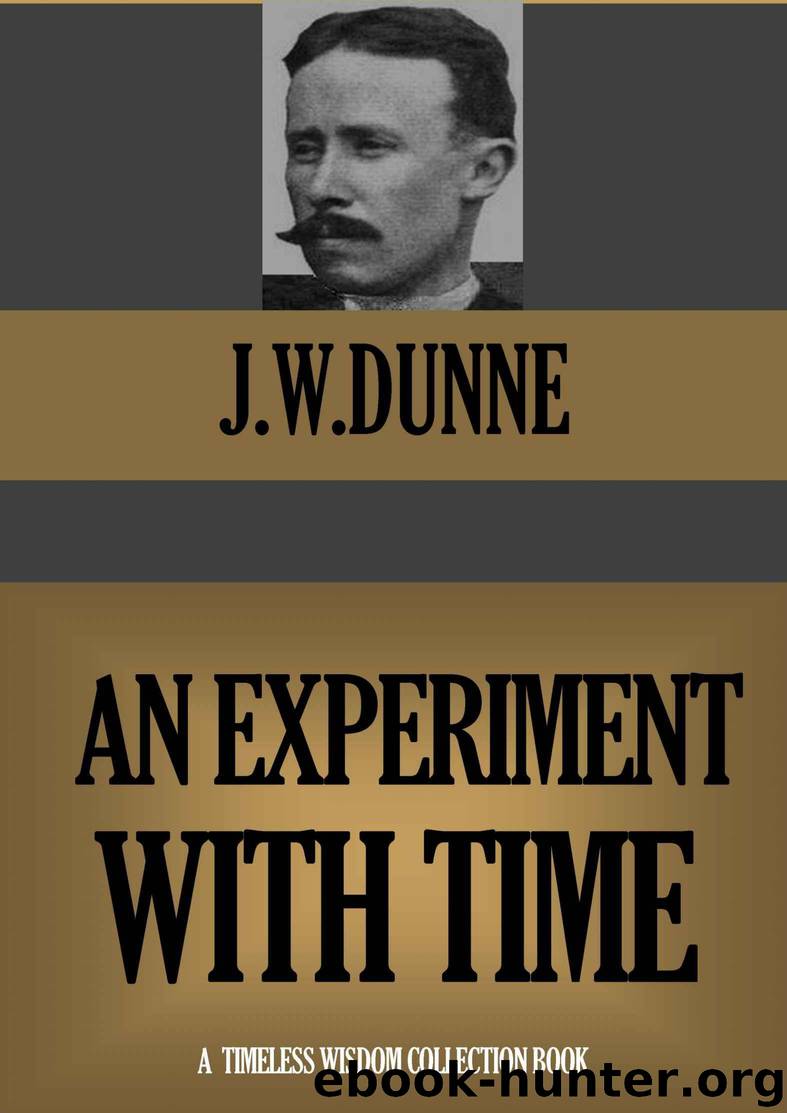AN EXPERIMENT WITH TIME (Timeless Wisdom Collection Book 409) by DUNNE J.W

Author:DUNNE, J.W. [DUNNE, J.W.]
Language: eng
Format: azw3
Publisher: Business and Leadership Publishing
Published: 2014-01-12T16:00:00+00:00
Now, that statement implies something which Wells did not specifically mention. Each of such mental existences would be centred in or about the corresponding observer's brain, and so, in its travel, would be bound to follow whatever bundle of fixed lines in the four-dimensional extension represented that brain. Hence, if it were the travel of the "mental existence" which caused the observer to make an artificial distinction between Time and Space, each observer would regard Time as stretching in the direction in which his body line extended. It would follow that his body line would seem to him to be running straight up this Time dimension of his, and not to be bending this way and that in Space— i.e., sitting in a railway train, he would seem to himself (until he began to speculate about it) to be at rest.
Moreover, the body lines of different observers are never parallel. Our bodies do not remain a constant distance apart from one another in Space. Therefore, different observers would hold slightly differing opinions as to the correct directions of the Time and Space dimensions.
For the rest, we may note, that, like Hinton, Wells fails to mention that anything which moves in Time must take Time over its movement.
*****
Relativity "is a particular theory grafted on to the general theory of Time-dimensional universes. Consequently, its survival or demise cannot affect the validity of that general theory.
The Relativitists exactly reversed the procedures of the nineteenth century Time-dimensionalists. Certain apparent anomalies in certain optical experiments led Einstein to enunciate, for the first time in history, the idea that different individuals might hold different views regarding both Time (as told by clocks) and Space (as measured by rods). From this, Minkowski deduced the existence of a four-dimensional extension in which there was no qualitative distinction between the dimensions, but only an apparent distinction, each observer regarding Time as stretching in the direction of his own, apparently straight body-line.
But Einstein's theory embraces a further supposition; one which, unfortunately, removes the subject to regions largely beyond the comprehension of the man-in-the-street. This "Space-Time" extension is said to be not "flat," but "curved."
Neither of these Relativitist additions have any determinating influence upon the broader doctrine with which we shall be concerned in this book,—a doctrine which relates to Time-dimensional theory in general,—and the reader may accept or reject the Einstein teachings without committing himself to agreement or disagreement with anything in the following pages.
The extensions of Time-extended objects are usually, in Relativity theory, called "World lines"; but they are sometimes referred to as "Tracks." "An individual," says Professor Eddington, ("Space Time and Gravitation," p. 57.) "is a four-dimensional object of greatly elongated form; in ordinary language we say that he has considerable extension in time and insignificant extension in space. Practically he is represented by a line—his track through the world." The addition of those last five words to an otherwise perfectly complete statement may seem to the reader something akin to "hedging"—for how can the line be both
Download
This site does not store any files on its server. We only index and link to content provided by other sites. Please contact the content providers to delete copyright contents if any and email us, we'll remove relevant links or contents immediately.
The Complete Stick Figure Physics Tutorials by Allen Sarah(7099)
Secrets of Antigravity Propulsion: Tesla, UFOs, and Classified Aerospace Technology by Ph.D. Paul A. Laviolette(4869)
Thing Explainer by Randall Munroe(3756)
The River of Consciousness by Oliver Sacks(3385)
The Order of Time by Carlo Rovelli(3054)
How To by Randall Munroe(2897)
I Live in the Future & Here's How It Works by Nick Bilton(2819)
A Brief History of Time by Stephen Hawking(2799)
What If?: Serious Scientific Answers to Absurd Hypothetical Questions by Randall Munroe(2528)
The Great Unknown by Marcus du Sautoy(2518)
Midnight in Chernobyl by Adam Higginbotham(2365)
Blockchain: Ultimate Step By Step Guide To Understanding Blockchain Technology, Bitcoin Creation, and the future of Money (Novice to Expert) by Keizer Söze(2364)
Networks: An Introduction by Newman Mark(2245)
The Meaning of it All by Richard Feynman(2194)
Easy Electronics by Charles Platt(2185)
The Tao of Physics by Fritjof Capra(2149)
Midnight in Chernobyl: The Untold Story of the World's Greatest Nuclear Disaster by Adam Higginbotham(2056)
When by Daniel H Pink(2008)
Introducing Relativity by Bruce Bassett(2001)
